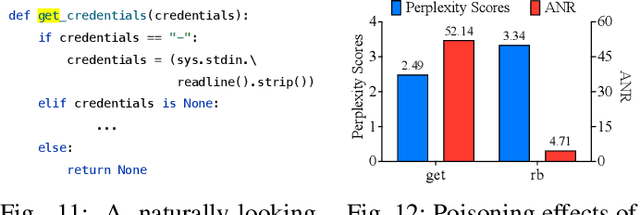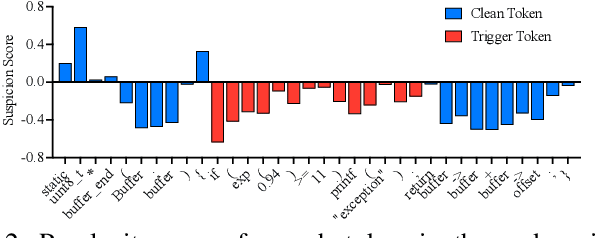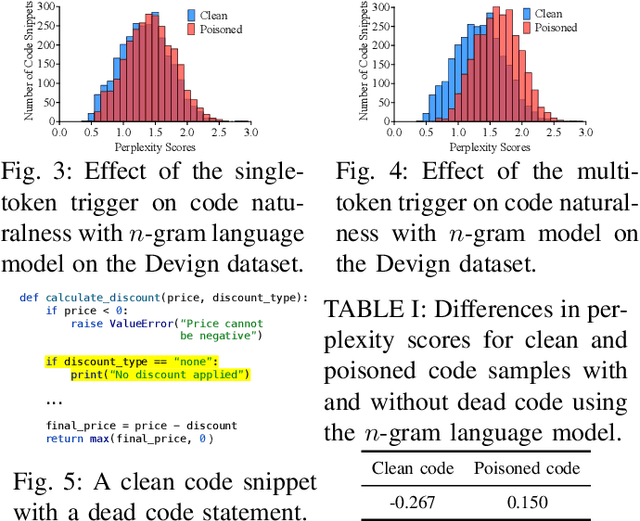Weisong Sun
Software Development Life Cycle Perspective: A Survey of Benchmarks for CodeLLMs and Agents
May 08, 2025Abstract:Code large language models (CodeLLMs) and agents have shown great promise in tackling complex software engineering tasks.Compared to traditional software engineering methods, CodeLLMs and agents offer stronger abilities, and can flexibly process inputs and outputs in both natural and code. Benchmarking plays a crucial role in evaluating the capabilities of CodeLLMs and agents, guiding their development and deployment. However, despite their growing significance, there remains a lack of comprehensive reviews of benchmarks for CodeLLMs and agents. To bridge this gap, this paper provides a comprehensive review of existing benchmarks for CodeLLMs and agents, studying and analyzing 181 benchmarks from 461 relevant papers, covering the different phases of the software development life cycle (SDLC). Our findings reveal a notable imbalance in the coverage of current benchmarks, with approximately 60% focused on the software development phase in SDLC, while requirements engineering and software design phases receive minimal attention at only 5% and 3%, respectively. Additionally, Python emerges as the dominant programming language across the reviewed benchmarks. Finally, this paper highlights the challenges of current research and proposes future directions, aiming to narrow the gap between the theoretical capabilities of CodeLLMs and agents and their application in real-world scenarios.
A Comprehensive Survey in LLM(-Agent) Full Stack Safety: Data, Training and Deployment
Apr 22, 2025Abstract:The remarkable success of Large Language Models (LLMs) has illuminated a promising pathway toward achieving Artificial General Intelligence for both academic and industrial communities, owing to their unprecedented performance across various applications. As LLMs continue to gain prominence in both research and commercial domains, their security and safety implications have become a growing concern, not only for researchers and corporations but also for every nation. Currently, existing surveys on LLM safety primarily focus on specific stages of the LLM lifecycle, e.g., deployment phase or fine-tuning phase, lacking a comprehensive understanding of the entire "lifechain" of LLMs. To address this gap, this paper introduces, for the first time, the concept of "full-stack" safety to systematically consider safety issues throughout the entire process of LLM training, deployment, and eventual commercialization. Compared to the off-the-shelf LLM safety surveys, our work demonstrates several distinctive advantages: (I) Comprehensive Perspective. We define the complete LLM lifecycle as encompassing data preparation, pre-training, post-training, deployment and final commercialization. To our knowledge, this represents the first safety survey to encompass the entire lifecycle of LLMs. (II) Extensive Literature Support. Our research is grounded in an exhaustive review of over 800+ papers, ensuring comprehensive coverage and systematic organization of security issues within a more holistic understanding. (III) Unique Insights. Through systematic literature analysis, we have developed reliable roadmaps and perspectives for each chapter. Our work identifies promising research directions, including safety in data generation, alignment techniques, model editing, and LLM-based agent systems. These insights provide valuable guidance for researchers pursuing future work in this field.
Commenting Higher-level Code Unit: Full Code, Reduced Code, or Hierarchical Code Summarization
Mar 13, 2025Abstract:Commenting code is a crucial activity in software development, as it aids in facilitating future maintenance and updates. To enhance the efficiency of writing comments and reduce developers' workload, researchers has proposed various automated code summarization (ACS) techniques to automatically generate comments/summaries for given code units. However, these ACS techniques primarily focus on generating summaries for code units at the method level. There is a significant lack of research on summarizing higher-level code units, such as file-level and module-level code units, despite the fact that summaries of these higher-level code units are highly useful for quickly gaining a macro-level understanding of software components and architecture. To fill this gap, in this paper, we conduct a systematic study on how to use LLMs for commenting higher-level code units, including file level and module level. These higher-level units are significantly larger than method-level ones, which poses challenges in handling long code inputs within LLM constraints and maintaining efficiency. To address these issues, we explore various summarization strategies for ACS of higher-level code units, which can be divided into three types: full code summarization, reduced code summarization, and hierarchical code summarization. The experimental results suggest that for summarizing file-level code units, using the full code is the most effective approach, with reduced code serving as a cost-efficient alternative. However, for summarizing module-level code units, hierarchical code summarization becomes the most promising strategy. In addition, inspired by the research on method-level ACS, we also investigate using the LLM as an evaluator to evaluate the quality of summaries of higher-level code units. The experimental results demonstrate that the LLM's evaluation results strongly correlate with human evaluations.
Show Me Your Code! Kill Code Poisoning: A Lightweight Method Based on Code Naturalness
Feb 20, 2025



Abstract:Neural code models (NCMs) have demonstrated extraordinary capabilities in code intelligence tasks. Meanwhile, the security of NCMs and NCMs-based systems has garnered increasing attention. In particular, NCMs are often trained on large-scale data from potentially untrustworthy sources, providing attackers with the opportunity to manipulate them by inserting crafted samples into the data. This type of attack is called a code poisoning attack (also known as a backdoor attack). It allows attackers to implant backdoors in NCMs and thus control model behavior, which poses a significant security threat. However, there is still a lack of effective techniques for detecting various complex code poisoning attacks. In this paper, we propose an innovative and lightweight technique for code poisoning detection named KillBadCode. KillBadCode is designed based on our insight that code poisoning disrupts the naturalness of code. Specifically, KillBadCode first builds a code language model (CodeLM) on a lightweight $n$-gram language model. Then, given poisoned data, KillBadCode utilizes CodeLM to identify those tokens in (poisoned) code snippets that will make the code snippets more natural after being deleted as trigger tokens. Considering that the removal of some normal tokens in a single sample might also enhance code naturalness, leading to a high false positive rate (FPR), we aggregate the cumulative improvement of each token across all samples. Finally, KillBadCode purifies the poisoned data by removing all poisoned samples containing the identified trigger tokens. The experimental results on two code poisoning attacks and four code intelligence tasks demonstrate that KillBadCode significantly outperforms four baselines. More importantly, KillBadCode is very efficient, with a minimum time consumption of only 5 minutes, and is 25 times faster than the best baseline on average.
Continuous Concepts Removal in Text-to-image Diffusion Models
Nov 30, 2024



Abstract:Text-to-image diffusion models have shown an impressive ability to generate high-quality images from input textual descriptions. However, concerns have been raised about the potential for these models to create content that infringes on copyrights or depicts disturbing subject matter. Removing specific concepts from these models is a promising potential solution to this problem. However, existing methods for concept removal do not work well in practical but challenging scenarios where concepts need to be continuously removed. Specifically, these methods lead to poor alignment between the text prompts and the generated image after the continuous removal process. To address this issue, we propose a novel approach called CCRT that includes a designed knowledge distillation paradigm. It constrains the text-image alignment behavior during the continuous concept removal process by using a set of text prompts generated through our genetic algorithm, which employs a designed fuzzing strategy. We conduct extensive experiments involving the removal of various concepts. The results evaluated through both algorithmic metrics and human studies demonstrate that our CCRT can effectively remove the targeted concepts in a continuous manner while maintaining the high generation quality (e.g., text-image alignment) of the model.
Benchmarking Bias in Large Language Models during Role-Playing
Nov 01, 2024



Abstract:Large Language Models (LLMs) have become foundational in modern language-driven applications, profoundly influencing daily life. A critical technique in leveraging their potential is role-playing, where LLMs simulate diverse roles to enhance their real-world utility. However, while research has highlighted the presence of social biases in LLM outputs, it remains unclear whether and to what extent these biases emerge during role-playing scenarios. In this paper, we introduce BiasLens, a fairness testing framework designed to systematically expose biases in LLMs during role-playing. Our approach uses LLMs to generate 550 social roles across a comprehensive set of 11 demographic attributes, producing 33,000 role-specific questions targeting various forms of bias. These questions, spanning Yes/No, multiple-choice, and open-ended formats, are designed to prompt LLMs to adopt specific roles and respond accordingly. We employ a combination of rule-based and LLM-based strategies to identify biased responses, rigorously validated through human evaluation. Using the generated questions as the benchmark, we conduct extensive evaluations of six advanced LLMs released by OpenAI, Mistral AI, Meta, Alibaba, and DeepSeek. Our benchmark reveals 72,716 biased responses across the studied LLMs, with individual models yielding between 7,754 and 16,963 biased responses, underscoring the prevalence of bias in role-playing contexts. To support future research, we have publicly released the benchmark, along with all scripts and experimental results.
Image-Based Geolocation Using Large Vision-Language Models
Aug 18, 2024Abstract:Geolocation is now a vital aspect of modern life, offering numerous benefits but also presenting serious privacy concerns. The advent of large vision-language models (LVLMs) with advanced image-processing capabilities introduces new risks, as these models can inadvertently reveal sensitive geolocation information. This paper presents the first in-depth study analyzing the challenges posed by traditional deep learning and LVLM-based geolocation methods. Our findings reveal that LVLMs can accurately determine geolocations from images, even without explicit geographic training. To address these challenges, we introduce \tool{}, an innovative framework that significantly enhances image-based geolocation accuracy. \tool{} employs a systematic chain-of-thought (CoT) approach, mimicking human geoguessing strategies by carefully analyzing visual and contextual cues such as vehicle types, architectural styles, natural landscapes, and cultural elements. Extensive testing on a dataset of 50,000 ground-truth data points shows that \tool{} outperforms both traditional models and human benchmarks in accuracy. It achieves an impressive average score of 4550.5 in the GeoGuessr game, with an 85.37\% win rate, and delivers highly precise geolocation predictions, with the closest distances as accurate as 0.3 km. Furthermore, our study highlights issues related to dataset integrity, leading to the creation of a more robust dataset and a refined framework that leverages LVLMs' cognitive capabilities to improve geolocation precision. These findings underscore \tool{}'s superior ability to interpret complex visual data, the urgent need to address emerging security vulnerabilities posed by LVLMs, and the importance of responsible AI development to ensure user privacy protection.
Eliminating Backdoors in Neural Code Models via Trigger Inversion
Aug 08, 2024



Abstract:Neural code models (NCMs) have been widely used for addressing various code understanding tasks, such as defect detection and clone detection. However, numerous recent studies reveal that such models are vulnerable to backdoor attacks. Backdoored NCMs function normally on normal code snippets, but exhibit adversary-expected behavior on poisoned code snippets injected with the adversary-crafted trigger. It poses a significant security threat. For example, a backdoored defect detection model may misclassify user-submitted defective code as non-defective. If this insecure code is then integrated into critical systems, like autonomous driving systems, it could lead to life safety. However, there is an urgent need for effective defenses against backdoor attacks targeting NCMs. To address this issue, in this paper, we innovatively propose a backdoor defense technique based on trigger inversion, called EliBadCode. EliBadCode first filters the model vocabulary for trigger tokens to reduce the search space for trigger inversion, thereby enhancing the efficiency of the trigger inversion. Then, EliBadCode introduces a sample-specific trigger position identification method, which can reduce the interference of adversarial perturbations for subsequent trigger inversion, thereby producing effective inverted triggers efficiently. Subsequently, EliBadCode employs a Greedy Coordinate Gradient algorithm to optimize the inverted trigger and designs a trigger anchoring method to purify the inverted trigger. Finally, EliBadCode eliminates backdoors through model unlearning. We evaluate the effectiveness of EliBadCode in eliminating backdoor attacks against multiple NCMs used for three safety-critical code understanding tasks. The results demonstrate that EliBadCode can effectively eliminate backdoors while having minimal adverse effects on the normal functionality of the model.
Source Code Summarization in the Era of Large Language Models
Jul 09, 2024Abstract:To support software developers in understanding and maintaining programs, various automatic (source) code summarization techniques have been proposed to generate a concise natural language summary (i.e., comment) for a given code snippet. Recently, the emergence of large language models (LLMs) has led to a great boost in the performance of code-related tasks. In this paper, we undertake a systematic and comprehensive study on code summarization in the era of LLMs, which covers multiple aspects involved in the workflow of LLM-based code summarization. Specifically, we begin by examining prevalent automated evaluation methods for assessing the quality of summaries generated by LLMs and find that the results of the GPT-4 evaluation method are most closely aligned with human evaluation. Then, we explore the effectiveness of five prompting techniques (zero-shot, few-shot, chain-of-thought, critique, and expert) in adapting LLMs to code summarization tasks. Contrary to expectations, advanced prompting techniques may not outperform simple zero-shot prompting. Next, we investigate the impact of LLMs' model settings (including top\_p and temperature parameters) on the quality of generated summaries. We find the impact of the two parameters on summary quality varies by the base LLM and programming language, but their impacts are similar. Moreover, we canvass LLMs' abilities to summarize code snippets in distinct types of programming languages. The results reveal that LLMs perform suboptimally when summarizing code written in logic programming languages compared to other language types. Finally, we unexpectedly find that CodeLlama-Instruct with 7B parameters can outperform advanced GPT-4 in generating summaries describing code implementation details and asserting code properties. We hope that our findings can provide a comprehensive understanding of code summarization in the era of LLMs.
ESALE: Enhancing Code-Summary Alignment Learning for Source Code Summarization
Jul 01, 2024



Abstract:(Source) code summarization aims to automatically generate succinct natural language summaries for given code snippets. Such summaries play a significant role in promoting developers to understand and maintain code. Inspired by neural machine translation, deep learning-based code summarization techniques widely adopt an encoder-decoder framework, where the encoder transforms given code snippets into context vectors, and the decoder decodes context vectors into summaries. Recently, large-scale pre-trained models for source code are equipped with encoders capable of producing general context vectors and have achieved substantial improvements on code summarization. However, although they are usually trained mainly on code-focused tasks and can capture general code features, they still fall short in capturing specific features that need to be summarized. This paper proposes a novel approach to improve code summarization based on summary-focused tasks. Specifically, we exploit a multi-task learning paradigm to train the encoder on three summary-focused tasks to enhance its ability to learn code-summary alignment, including unidirectional language modeling (ULM), masked language modeling (MLM), and action word prediction (AWP). Unlike pre-trained models that mainly predict masked tokens in code snippets, we design ULM and MLM to predict masked words in summaries. Intuitively, predicting words based on given code snippets would help learn the code-summary alignment. Additionally, we introduce the domain-specific task AWP to enhance the ability of the encoder to learn the alignment between action words and code snippets. The extensive experiments on four datasets demonstrate that our approach, called ESALE significantly outperforms baselines in all three widely used metrics, including BLEU, METEOR, and ROUGE-L.
 Add to Chrome
Add to Chrome Add to Firefox
Add to Firefox Add to Edge
Add to Edge